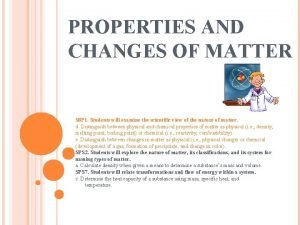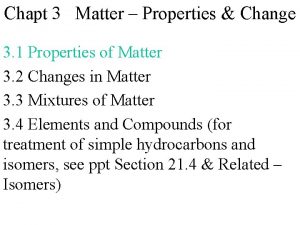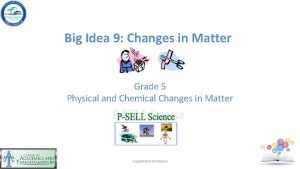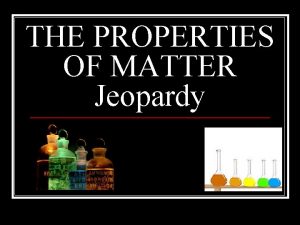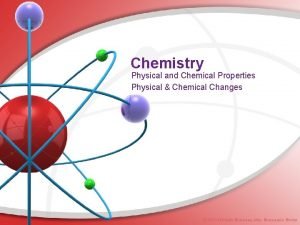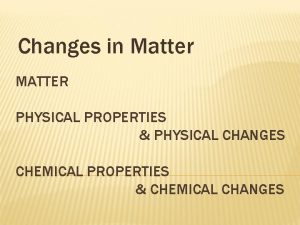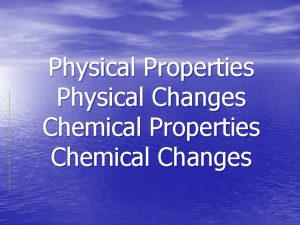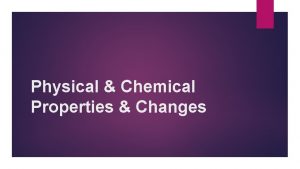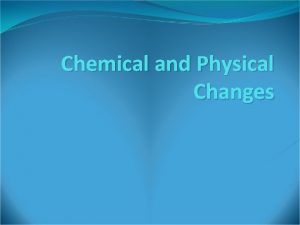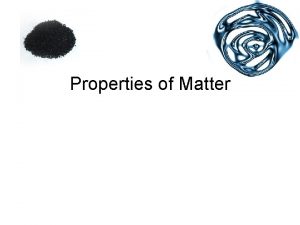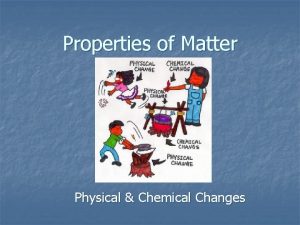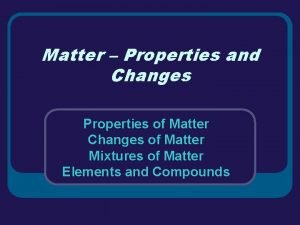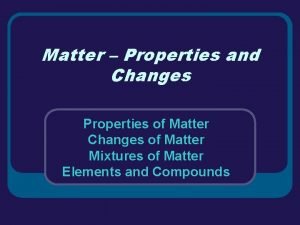PHYSICAL PROPERTIES OF MATTER WHEN MATTER CHANGES STATE













- Slides: 13

PHYSICAL PROPERTIES OF MATTER: WHEN MATTER CHANGES STATE EQ: What happens when matter changes state?

Chemical Changes Physical Changes can undergo Solid Liquid MATTER states Gas all matter has identified by Chemical Properties flammability toxicity Mas s Volum e Physical Properties reactivity oxidation Melting Point Density Solubility Volume Freezing Point

PHYSICAL & CHEMICAL CHANGES • Matter can undergo 2 types of changes: physical changes and chemical changes. • It is important to note that all matter can go through changes! • Do you have any idea what the differences between the 2 are? • Can you give any examples of a physical change or a chemical change?

PHYSICAL & CHEMICAL CHANGES Does this help? • Physical Change • Chemical Change

Physical Change: A change in which no new substances are formed It does not change the type of matter the object is made of. It can change the shape, size or phase of the matter. Many physical changes can be easily reversed.

A CLOSER LOOK AT PHYSICAL CHANGES… • Brainstorm a list of physical changes that we as humans can go through. {Be prepared to share your best idea} • Brainstorm a list of physical changes that matter can go through. {Be prepared to share your best idea} • Think of a few ways that you could physically change this piece of paper that I am giving you. How many different ways can you think of? {Pick your most creative idea and demonstrate it} Think: change in size, form, texture, shape, or phase

Examples of physical changes: • Which of these are changes to the state of matter? {solids, liquids, gases}

REVIEW Phase Solid Motion of Particles vibrate in place and are tightly packed Speed of Particles Slow Liquid Particles are close, but can slide past one another Medium Gas Particles are constantly expanding and are far apart Fast

What might cause the particles in solids, liquids, and gases to move faster and expand or start to slow down and pack tighter together?

REVIEW & REINFORCEMENT GAME • For this activity, you will be selecting 2 white cards from the Science folder. • Look back in your notes and determine whether the clue on the card is a clue to a solid, liquid, or gas. • In a moment, you will be receiving a secret card on your back that says: Solid Liquid or Gas • When you are instructed to, you will travel around the room giving away 2 clue cards & receiving 2 clue cards. • You will look at the clue cards that students give you and determine whether your secret card says: Solid, Liquid, or Gas

WHAT REACTION DID YOU HAVE TO HEAT? • It’s all about the addition of heat or the loss of heat! You can make a connection to something that you already know: • Penguins huddle together, tightly packed, and move very little when the weather gets very cold. • If an extremely hot heat source came close to a group of people, you would all probably scatter away quickly expanding out in all directions.

Ø As temperature increases, the energy of the particles and motion increases. Meaning that the atoms move more quickly Check out: http: //phet. colorado. edu/en/simulation/states-of-matter-basics

Most substances can exist as a solid, liquid, or gas depending on temperature.
 Physical change definition
Physical change definition Properties and changes of matter worksheet
Properties and changes of matter worksheet Matter-properties and changes answer key
Matter-properties and changes answer key Changes in matter grade 5
Changes in matter grade 5 Physical/chemical changes & properties color by number
Physical/chemical changes & properties color by number Chemical properties
Chemical properties True or false: chemical and physical changes alter matter.
True or false: chemical and physical changes alter matter. Change of state of matter
Change of state of matter Physical properties and chemical properties
Physical properties and chemical properties Physical properties of matter jeopardy
Physical properties of matter jeopardy Properties of matter graphic organizer
Properties of matter graphic organizer Chemical properties of notebook paper
Chemical properties of notebook paper 2 properties of liquids
2 properties of liquids Changes in latitudes, changes in attitudes meaning
Changes in latitudes, changes in attitudes meaning

